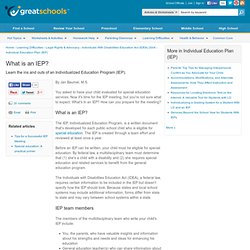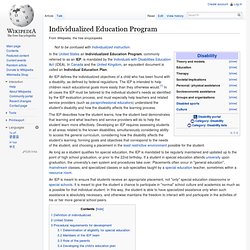

Individualized Education Program (IEP) Learn the ins and outs of an Individualized Education Program (IEP). By Jan Baumel, M.S.

You asked to have your child evaluated for special education services. Now it's time for the IEP meeting, but you're not sure what to expect. What's in an IEP? How can you prepare for the meeting? What is an IEP? The IEP, Individualized Education Program, is a written document that's developed for each public school child who is eligible for special education. Before an IEP can be written, your child must be eligible for special education.
The Individuals with Disabilities Education Act (IDEA), a federal law, requires certain information to be included in the IEP but doesn't specify how the IEP should look. IEP team members The members of the multidisciplinary team who write your child's IEP include: Individualized Education Program (IEP) - Special Education. Guide to the Individualized Education Program. 1.

Preface The purpose of this guidance is to assist educators, parents, and state and local educational agencies in implementing the requirements of Part B of the Individuals with Disabilities Education Act (IDEA) regarding Individualized Education Programs (IEPs) for children with disabilities, including preschool-aged children. (This guide does not address the development of Individualized Family Service Plans (IFSP) for infants and toddlers.)
Guide to the Individualized Education Program Office of Special Education and Rehabilitative Services U.S. Credits This guide was developed by the U.S. Editor: Lisa Küpper, NICHCY Production: Jean Kohanek, NICHCY Disability Art: Madison, Moore, www.disabilityart.com Additional copies of this guide are available from: ED Pubs Editorial Publications Center U.S. . (877) 4-ED-PUBS (877) 576-7734 TTY (301) 470-1244 Fax This document is also available online at: MS Word (145K) 2. The IDEA requires certain information to be included in each child's IEP. 3. 4. 5. Individualized Education Program - Wikipedia, the free ... In the United States an Individualized Education Program, commonly referred to as an IEP, is mandated by the Individuals with Disabilities Education Act (IDEA).

In Canada and the United Kingdom, an equivalent document is called an Individual Education Plan. An IEP defines the individualized objectives of a child who has been found with a disability, as defined by federal regulations. The IEP is intended to help children reach educational goals more easily than they otherwise would.[1] In all cases the IEP must be tailored to the individual student's needs as identified by the IEP evaluation process, and must especially help teachers and related service providers (such as paraprofessional educators) understand the student's disability and how the disability affects the learning process.
The IEP describes how the student learns, how the student best demonstrates that learning and what teachers and service providers will do to help the student learn more effectively. United States[edit] Individualized Education Plans (IEPs) Developing an IEP The next step is an IEP meeting at which the team and parents decide what will go into the plan.

In addition to the evaluation team, a regular teacher should be present to offer suggestions about how the plan can help the child's progress in the standard education curriculum. At the meeting, the team will discuss your child's educational needs — as described in the CER — and come up with specific, measurable short-term and annual goals for each of those needs. If you attend this meeting, you can take an active role in developing the goals and determining which skills or areas will receive the most attention. The cover page of the IEP outlines the support services your child will receive and how often they will be provided (for example, occupational therapy twice a week). If the team recommends several services, the amount of time they take in the child's school schedule can seem overwhelming.